Design and Development of an Internet of Things Based Package Reception Box System
on
JURNAL ILMIAH MERPATI VOL. 11, NO. 2 AUGUST 2023 p-ISSN: 2252-3006
e-ISSN: 2685-2411
Design and Development of an Internet of Things Based Package Reception Box System
Eva Martina Sitorus a1, I Made Agus Dwi Suarjayaa2, I Putu Agung Bayupatia3 aDepartment of Information Technology, Faculty of Engineering, Udayana University, Bukit Jimbaran, Bali, Indonesia, phone. (0361) 701806
e-mail: 1evamartinas289@gmail.com, 2agussuarjaya@it.unud.ac.id, 3bayupati@unud.ac.id
Abstrak
Jasa pengiriman paket membantu masyarakat dalam mengirimkan dan menerima barang dengan mudah dan cepat. Sektor jasa pengiriman paket meningkat sebesar 33,62% semenjak terjadinya pandemic Covid-19. Seringkali terdapat beberapa masalah pada saat penerimaan paket seperti paket rusak dan hilang. Dari permasalahan tersebut, makadirancang dan dibangun sebuah sistem kotak penerimaan paket dengan menggunakan teknologi Internet of things (IoT). Sistem bekerja dengan menggunakan UART GM66 Barcode Scanner, ESP-32CAM, Solenoid Door Lock, dan Motor Stepper Nema 17. Tujuan dari penelitian ini adalah membangun sistem kotak penerimaan paket secara otomatis yang dapat dikendalikan melalui smartphone yang aman dari pencurian dan kerusakan paket. Pengujian sistem dilakukan pada fungsionalitas alat dan komunikasi dengan bot telegram.
Kata kunci: Paket, ESP32-CAM, Barcode Scanner, Telegram Bot, Internet of Things
Abstract
Parkage delivery services play a crucial role in facilitating the easy and prompt sending and receiving of goods to the public. The package delivery sector has witnessed significant growth of 33.62% since the outbreak of the Covid-19 pandemic. However, package receipt often presents challenges, including instances of damaged or lost packages. To address these issues, a system for package reception was designed and developed utilizing the Internet of Things (IoT) technology. The system operates by incorporating a UART GM66 Barcode Scanner, ESP-32CAM, Solenoid Door Lock, and Motor Stepper Nema 17. The primary objective of this research is to construct an automated package-reception system that can be controlled securely through a smartphone, thus ensuring protection against theft and package damage. System testing was performed on the functionality of the tool and communication with the telegram bot.
Keywords : Package, ESP32-CAM, Barcode Scanner, Telegram Bot, Internet of Things
The increasingly advanced and sophisticated era certainly goes hand-in-hand with the development of various businesses and industries. One growing business is package delivery services. Package delivery service are facilities that can be used by the public to send goods to the intended place in physical form such as important documents, securities, and electronic products, which are will be accompanied by responsibility from the service. The package delivery service sector has increased by 33.62% since the start of the Covid-19 pandemi [1]
The delivery of packages to the recipient is usually done by the courier assigned by the delivery service. Often, there are several problems when receiving packages, such as packages thrown carelessly by the courier causing the package to be damaged, packages that are lost even though the courier has placed it at the door, and owners who are not at home at the time of the courier giving the package that can result in repeated delivery by the courier. If the courier repeatedly tries to deliver the package, it will be sent back to the sender of the package. Many negative reviews of courier negligence that caused losses from package owners and delivery services [2]. In addition, homeowners are sometimes reluctant to meet the courier directly when
receiving their packages to prevent frequent contact and interaction, homeowners are sometimes reluctant to meet the courier directly when receiving their packages [3].
The package-receiving box system works using a UART GM66 Barcode Scanner, ESP-32CAM, Solenoid Door Lock, and Nema 17 Stepper Motor. Couriers can scan package receipts using barcode scanners to open package boxes and homeowners can control and monitor the work of the system through a telegram bot application on smartphones. The purpose of this research is expected to overcome user problems in security and ease of receiving packages by utilizing internet of things technology.
The research method used was a prototyping method based on the basic principle of the model in the final system. By using prototyping methods, system development will be more effective and cost-efficient. The stage of this method begins from data collection to system evaluation.
The research flow includes the design of activities that will be carried out from beginning to end to achieve the research results. The following is the research flow of the prototyping methods.

Figure 1. Research Flow
The stages of this method begin with collection of needs from the system. Furthermore, prototype development is carried out along with an evaluation to determine the prototype, and the requirements are appropriate. If appropriate, proceed to the system coding stage. After the program was successfully created, the system was tested and evaluated to determine whether the program had been correctly applied and whether there were any obstacles. Furthermore, users can use this system [4].
The overview describes the system using images that represent each process flow.

input
♦Notification
User

message
output
Smartphone

Telegram bot

Power Supply
power
output
input

Magnetic Door Switch Sensor
output input 11

UART GM-66
Barcode Scanner

Solenoid Door Lock

Driver A4988
scan

Move a circle
Package Box
Figure 2. System Overview

Motor Stepper Nema 17
Users can input commands in the form of messages regarding package receipt numbers to the telegram bot by using smartphones. The telegram sends the receipt to the microcontroller. The ESP32-CAM will provide output to the UART GM-66, Solenoid Door Lock, A4988 Driver, and Nema 17 Stepper Motor. Meanwhile, the Magnetic Door Sensor provides input to the ESP32-CAM to detect movements from the box door.
Hardware needs include tools and materials in physical form that are used to support research. The following is an analysis of the hardware requirements of the package-receipt-box system.
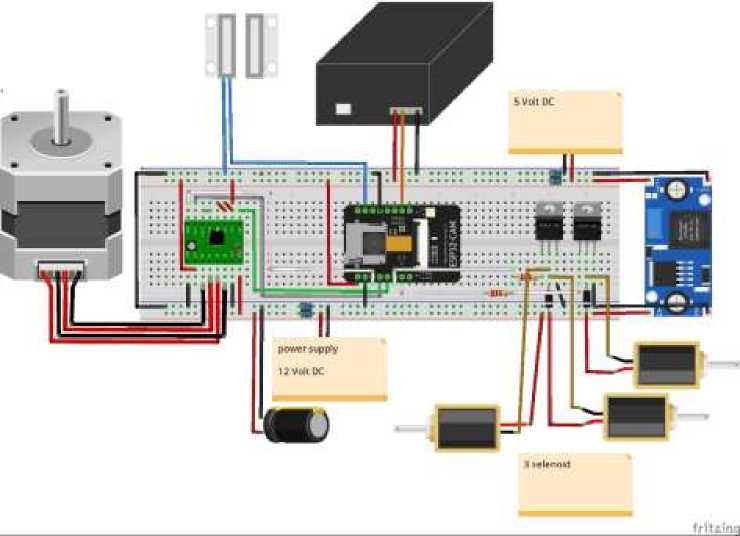
Figure 3. Schematic Diagram
ESP32-CAM is used as a microcontroller to regulate the operation of the system [5]. The UART GM-66 Barcode Scanner, solenoid door lock, Magnetic Door Sensor, and Nema 17 Stepper Motor were used to run the designed system. There is also a 12 V power supply from the adapter for input so that the system can run, the A4988 Driver that will drive the stepper motor, and LM2596 DC as a voltage lower.
Software needs are tools and materials in the form of applications or software used to support the research. The following is an analysis of the software requirements for the package receipt box system.
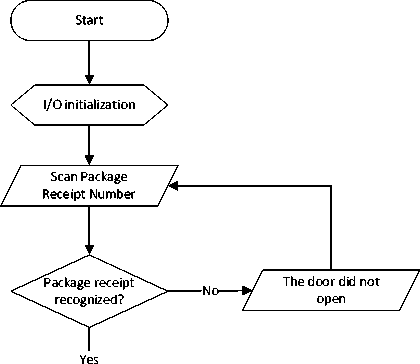
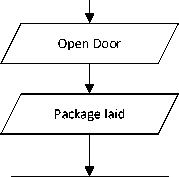
Camera Capture

Notifications are sent to owners via telegram bot


Figure 4. Courier Flowchart
When the courier delivers the package to the homeowner, the courier goes to the box and scans the barcode receipt on the barcode scanner provided [6]. Furthermore, if the package receipt is recognized, the box door will open, whereas if the receipt package is not recognized, the door will remain closed. The courier can put the package in the box room and close the door again. The ESP32-CAM camera captures images and sends a notification to the homeowner via telegram in the form of photos and information regarding the placement of the package has been placed in the box.

Connecting to telegram bots
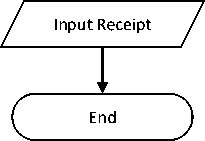
Figure 5. Flowchart Bot Telegram
Homeowners can open the telegram bot and input receipts based on predetermined commands. The number of receipts that can be input is three, according to the number of available spaces in the package box.
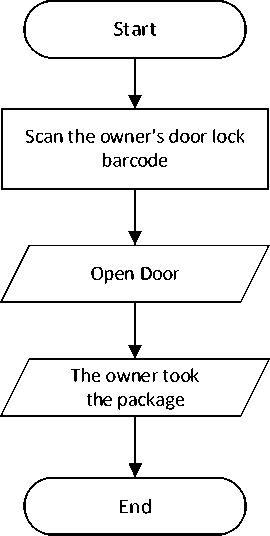
Figure 6. Homeowners Flowchart
Homeowners can scan the barcode which is the owner’s master key. Then, the box door opens, and the owner can pick up the package in any room in the box.
Tool design is the next stage after identifying the hardware and software requirements. The design of the tool can include both the design of the box and the schematic of the system.

Figure 7. Homeowners Flowchart
The box consists of three rooms with a circular base that can rotate the room using a nema 17 stepper motor. On two sides of the room, the divider is given a solenoid door lock, which is used to lock the room divider. The courier can place the package by opening the door of the package box and placing it in the available circular room.
Literature studies are useful for collecting data from journals or books that discuss research topics. The obtained knowledge and theory can be used as a reference to support research and system creation.
The ESP32-CAM microcontroller has advantages over other microcontrollers, namely the addition of Bluetooth 4.2 with BLE, 802.11 b/g/n Wi-Fi, 2 MP camera sensor, even up to the micro SD slot [7]. ESP32-CAM is often used for internet of things projects for camera features such as tracking and image recognition The ESP32-CAM module requires a USB TTL or additional downloader module to transmit programs from the computer [8]. Examples of applications of ESP32-CAM include smart home devices, QR wireless identification, wireless monitoring and wireless positioning [9].
The GM-66 Barcode scanner is an internet of things module used as 1D and 2D barcode readers with high performance. The GM-66 Barcode Scanner can operate stably in the range of high temperatures and dark conditions [10]. Communication from the GM-66 Barcode Scanner using USB and UART. The GM-66 Barcode Scanner is commonly used in logistics, retail, e-commerce, and other fields. This tool operates at a voltage of 5 Volts [11].
A Solenoid Door Lock is an electronic door lock that uses a solenoid and electromagnetic as its working principle. By using a voltage of 9-12 Volt DC, the door lock solenoid can work well to open a lock [12]. The way solenoid door-lock works is that when power and energy are given to the copper wire, the solenoid attached to the lock will be magnetically pulled into the middle of the copper wire coil. However, when the power is removed, the magnetic field decreases and the spring pushes the solenoid back to the locked state [13].
Stepper motors can convert power generated by electricity into mechanical energy. The Nema 17 stepper motor has a step angle of 1.8º, which can divide one full turn into 200 steps. This stepper motor has a torque of 45 N.cm, is equipped with a 4-pin cable to connect to the microcontroller to be used, and can vary the angle for rotation, which makes it easy to use the control without being monitored by the position of the motor [14].
A magnetic door sensor can be used to detect closed- or open-door conditions. The working principle of this sensor is that when the door closes, the magnet is activated, and the two sensor cables are connected [15]. The magnetic door sensor has an input power of 3 W, two cables for the VCC/GND and a signal indicator. Magnetic Door Sensors are frequently used to safeguard doors, boxes, and windows.
The testing result and discussion phases help the user evaluate the system. Testing will be carried out in the form of simulating package reception box system tools, communication to telegram bot, box design, and running functions for users.
Tool design assists in identifying the hardware and software requirements. The design of the tool can include both the design of the box and the schematic of the system.

Figure 8. Implementation of Package Receiving Box System
Figure 8 shows that the box shape is displayed on a closed door, open door, and open cover. The implementation of the package receipt box was in accordance with the design and function. Internet of things devices are strategically placed meticulously in boxes according to their respective functions. To allow users to scan the receipt barcode on the package, the position of the UART GM-66 barcode scanner is placed outside the box. Inside the box, other optimally positioned devices such as ESP32-CAM, Magnetic door sensor, Solenoid door lock, Nema 17 stepper motor, and A4988 driver.
Telegram bot are used for communication between user systems. A bot telegram makes it easy for users to monitor and give commands to the system.
SistemKotak bot

BOT @SistemKotakBot online.
Menu;
/list = Menampilkan daftar nomor resi.
/secret = Mengganti password Pemilik.
/id = Tambah nomor resi.
/wifi = Masukkan SSID dan PASSWORD WIFI dengan;
-
Figure 9. Bot Telegram
The image is a telegram bot that communicates with the package-receipt box system. Users can send commands to the system via a bot. Commands that can be performed in the form of displaying a list of package receipt numbers that have been inputted, changing the owner's password, adding the package receipt number, and changing the SSID and password provided.
Test results were obtained from repeated tests for accuracy and comparison. Testing of the package-receipt box system was performed on a telegram bot, courier scenarios, and homeowner scenarios.
Telegram bot testing was performed three times using pre-programmed commands. The command is tested in the form of activating the telegram bot, adding package receipts, displaying a list of package receipts, changing the owner key password, changing the SSID connection and WIFI password, and sending package images.
|
Table 1. Telegram Bot Test Results | |||
|
Scenario |
Recurrence I |
Recurrence II |
Recurrence III |
|
Activating telegram bot |
Succeeded |
Succeeded |
Succeeded |
|
Add the receipt of the package |
Succeeded |
Succeeded |
Succeeded |
|
Display a list of package |
Succeeded |
Succeeded |
Succeeded |
|
receipts Changing the owner's key |
Succeeded |
Succeeded |
Succeeded |
|
password Changing WIFI connection |
Succeeded |
Succeeded |
Succeeded |
|
(SSID and Password) Sending package images |
Succeeded |
Succeeded |
Succeeded |
Table 1 shows the results of telegram bot testing. In the telegram bot of the packagereception box system, there are several commands for running the system. From the results of the three tests, it was determined that the command and scenario were successfully implemented.
Courier scenario testing was conducted by trying the functions and features of the couriers three times. The test can be said to be successful if the system can read the barcode of the package receipt, the door opens, a picture of the package is taken, the safety lock of the room opens, and the package room changes to an empty room. If there is a failure during testing, such as when the receipt barcode on the package is not read by the scanner, there are several possible causes, namely damage to the receipt barcode contained in the package, the homeowner has not inputted the package receipt number into the system, or the package box has reached the storage capacity limit. The solution that can be provided is that the courier can contact the homeowner through the phone number listed on the box in order to reach an agreement.
|
Table 2. Courier Scenario Test Results | |||
|
Scenario |
Recurrence I |
Recurrence II |
Recurrence III |
|
Reading the barcode of the package receipt |
Succeeded |
Succeeded |
Succeeded |
|
Open door |
Succeeded |
Succeeded |
Succeeded |
|
Taking a picture of the package |
Succeeded |
Succeeded |
Succeeded |
|
Open room safety lock |
Succeeded |
Succeeded |
Succeeded |
|
The package room changed to an empty room |
Succeeded |
Succeeded |
Succeeded |
Table 2 shows the results of the testing with courier scenarios. The courier can deliver the package to the recipient through a box system. The results of testing the scenario three times showed, that the functions and features of couriers were successfully performed.
Homeowner scenario testing was performed by trying out the functions and features of the homeowner thrice. The test can be said to be successful if the system can read the lock barcode from the owner, and lock the door, and open room safety.
|
Table 3. Homeowners Scenario Test Results | ||
|
Scenario Recurrence I |
Recurrence II |
Recurrence III |
|
Reading the owner's key Succeeded barcode |
Succeeded |
Succeeded |
|
Door locks and open room Succeeded safety |
Succeeded |
Succeeded |
Table 3 shows the results of testing with homeowner scenarios. The recipient receives and retrieves the package through a box system. From the results of testing the scenario three times, it was found that the functions and features for homeowners were successfully carried out.
The designed and implemented package receipt box system is expected to meet user needs in terms of security and effectiveness in receiving packages. Based on the overall results of the repeated tests, the package receipt box system met these expectations. The packagereceiving box system is already capable of receiving packages from couriers, and homeowners can pick them from the box. The telegram bot, which is a means of communication between users and the system, can also run properly according to the commands given.
References
-
[1] Y. Anggoro, M. Wasesa, R. A. Rahadi, and K. F. Afgani, “Whitepaper Jasa Pengiriman
Ekspres di Indonesia,” ResearchGate, no. February, p. 24, 2022.
-
[2] E. A. Prasada, “BARANG KEPADA KONSUMEN ( STUDI KASUS PADA J & T
EXPRESS DI KAYUAGUNG ) Drop Point merupakan tempat untuk,” pp. 59–71.
-
[3] A. A. Musyafah, H. W. Khasna, and B. E. Turisno, “Perlindungan Konsumen Jasa
Pengiriman Barang Dalam Hal Terjadi Keterlambatan Pengiriman Barang,” Law Reform, vol. 14, no. 2, p. 151, 2018, doi: 10.14710/lr.v14i2.20863.
-
[4] N. Putri, N. Agung Prabowo, and R. A. Widyanto, “Implementasi Metode Prototyping
pada Perancangan Aplikasi Electronic Ticket (E-Ticket) berbasis Android,” J. Komtika (Komputasi dan Inform., vol. 3, no. 2, pp. 62–68, 2020, doi: 10.31603/komtika.v3i2.3474.
-
[5] I. Karlina, L. Nur, M. Safry, A. Mubarrok, and A. Jefiza, “Kunci Portable Berbasis IoT
Menggunakan QR Code , Android dan REST API,” vol. 2, no. 2, pp. 1–9, 2021.
-
[6] T. Lonika and S. Hariyanto, “Simulasi Smart Door Lock Berbasis QR Code
Menggunakan Arduino Uno Pada Penyewaan Apartemen Online,” J. ALGOR, vol. 1, no. 1, pp. 9–15, 2019.
-
[7] D. Setiawan, H. Jaya, and S. Nurarif, dkk, “Implementasi ESP32-Cam Dan Blynk Pada
Wifi Door Lock,” J. Sci. Soc. Res., vol. 5, no. 1, pp. 159–164, 2022.
-
[8] A. Putra, M. Susilo, D. Darlis, and D. A. Nurmantris, “Pengenalan Wajah Berbasis
Esp32-Cam Untuk Sistem Kunci Sepeda Motor Esp32-Cam-Based Face Recognition for Motorcycle,” J. Elektro Telekomun. Terap., vol. 8, no. 2, pp. 1091–1103, 2021.
-
[9] T. Akhir, “Jurnal FUSE – Teknik Elektro System Management Informasi Akademik
berbasis QR Code pada,” vol. 2, no. 1, pp. 41–50, 2022.
-
[10] H. HERIANSYAH, R. E. R, D. A. S, and S. ISTIQPHARA, “Sistem Kunci Pintu Otomatis Kelas Perkuliahan Berbasis Android Terintegrasi Sistem Informasi Akademik,” MIND J., vol. 5, no. 2, pp. 121–134, 2021, doi: 10.26760/mindjournal.v5i2.121-134.
-
[11] S. Buka, T. Pintu, R. Berbasis, I. O. T. Menggunakan, and Q. R. Code, “SISTEM BUKA TUTUP PINTU RUMAH BERBASIS IOT MENGGUNAKAN QR CODE Imam Yusuf Rofii,” vol. 1, no. 1, pp. 121–127, 2021.
-
[12] A. Uno, P. T. Xyz, R. S. K, and G. Sembada, “Jurnal E-KOMTEK ( Elektro-Komputer-Teknik ) Perancangan Sistem Keamanan Menggunakan Solenoid Door Lock Berbasis,” vol. 4, no. 1, pp. 62–74, 2020.
-
[13] A. Iskandar, M. Muhajirin, and L. Lisah, “Sistem Keamanan Pintu Berbasis Arduino
Mega,” J. Inform. Upgris, vol. 3, no. 2, pp. 99–104, 2017, doi: 10.26877/jiu.v3i2.1803.
-
[14] B. Suhendro, L. M. Antoro, and S. Suroso, “Sistem Kendali Penggerak Motor Stepper
Pada Orbital Welding Menggunakan Perangkat Lunak LabVIEW,” Pros. SNFA (Seminar Nas. Fis. dan Apl., vol. 5, pp. 47–56, 2020, doi: 10.20961/prosidingsnfa.v5i0.46593.
-
[15] G. Albashit Satoya and D. Haryo Sulaksono, “Positif: Jurnal Sistem dan Teknologi Informasi IMPLEMENTASI SENSOR MAGNETIC DOOR SWITCH UNTUK KEAMANAN LACI UANG YANG BERBASIS INTERNET OF THINGS(IOT) STUDI KASUS TOKO SATOYA,” 2021.
Design and Development of an Internet of Things Based Package Reception Box System 79
(Eva Martina Sitorus)
Discussion and feedback